-
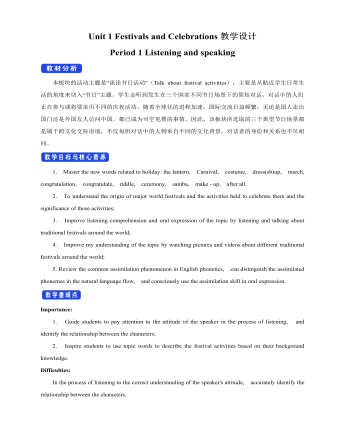
新人教版高中英语必修3Unit 1 Festivals and Celebrations教学设计一
本板块的活动主题是“谈论节日活动”(Talk about festival activities),主要是从贴近学生日常生活的角度来切入“节日”主题。学生会听到发生在三个国家不同节日场景下的简短对话,对话中的人们正在参与或将要亲历不同的庆祝活动。随着全球化的进程加速,国际交流日益频繁,无论是国人走出国门还是外国友人访问中国,都已成为司空见惯的事情。因此,该板块所选取的三个典型节日场景都是属于跨文化交际语境,不仅每组对话中的人物来自不同的文化背景,对话者的身份和关系也不尽相同。1. Master the new words related to holiday: the lantern, Carnival, costume, dress(sb)up, march, congratulation, congratulate, riddle, ceremony, samba, make - up, after all. 2. To understand the origin of major world festivals and the activities held to celebrate them and the significance of these activities;3. Improve listening comprehension and oral expression of the topic by listening and talking about traditional festivals around the world;4. Improve my understanding of the topic by watching pictures and videos about different traditional festivals around the world;5. Review the common assimilation phenomenon in English phonetics, can distinguish the assimilated phonemes in the natural language flow, and consciously use the assimilation skill in oral expression. Importance:1. Guide students to pay attention to the attitude of the speaker in the process of listening, and identify the relationship between the characters;2. Inspire students to use topic words to describe the festival activities based on their background knowledge. Difficulties:In the process of listening to the correct understanding of the speaker's attitude, accurately identify the relationship between the characters.

新人教版高中英语必修3Unit 2 Morals and Virtues教学设计二
Activity 41. Students complete the task of activity 4, then teachers and students check the answers. 2. The teacher organized the students to work together and asked them to use the tables and mind maps sorted out before to retold the important choices in Lin Qiaozhi's life and their resultsStep 5 Language points1. The teacher asks the students to read the text carefully, find out the core words and long and difficult sentences in the text and draw lines, understand the use of vocabulary, and analyze the structure of long and difficult sentences. 2. The teacher explains and summarizes the usage of core vocabulary and asks the students to take notes. 3. The teacher analyzes and explains the long and difficult sentences that the students don't understand, so that the students can understand them better. Step 6 Homework1. Read the text again, in-depth understanding of the text; 2. Master the use of core vocabulary and understand the long and difficult sentences. 3. Complete relevant exercises in the guide plan. 1、通过本节内容学习,学生是否理解和掌握阅读文本中的新词汇的意义与用法;2、通过本节内容学习,学生能否结合文本特点总结林巧稚的人生原则和人格品质特征;3、通过本节内容学习,学生能否针对人生抉择发表自己的看法;能否全面地、客观地、理性地看待问题,进而对道德和人性有更加深入的思考和理解。

新人教版高中英语必修3Unit 2 Morals and Virtues教学设计三
The joke set her crying.这个玩笑使她哭起来。Step 5 ReadingActivity 31. Students read the small text in activity 3. The teacher provides several small questions to check whether students understand the content of the text and the ideographic function of the -ing form in the text.*Where are those people?*Why did Dr Bethune come to China?*How did he help the Chinese people during the war?*What did Chairman Mao Zedong say about him?2. Ss try to rewrite some sentences using the -ing form. Then check the answers. When checking the answers, the teacher can ask different students to read the rewritten sentences and give comments.Answers:1. he became very interested in medicine, deciding to become a doctor.2. …after hearing that many people were dying in the war.3. Helping to organise hospitals, he taught doctors and nurses, and showed people how to give first aid./ He helped to organise hospitals, teaching doctors and nurses, and showing people how to give first aid.4. …praising Dr Bethune as a hero to be remembered in China.Step 6 PracticeActivity 4Students complete grammar activities 2 and 3 on page 69 of the workbook.Step 6 Homework1. Understand and master the functions and usage of the -ing form;2. Finish the other exercises in Using structures.1、通过本节内容学习,学生是否理解和掌握动词-ing形式作宾语补足语语和状语语的功能和意义;2、通过本节内容学习,学生能否正确使用动词-ing形式描述人物的行为、动作及其经历;3、通过本节内容学习,学生能否独立完成练习册和导学案中的相关练习。
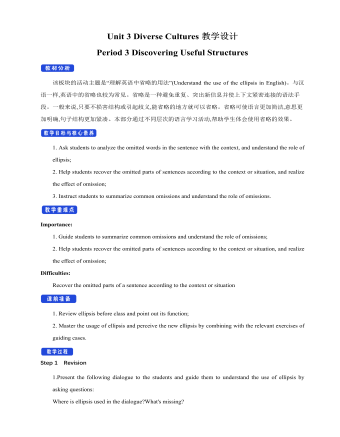
新人教版高中英语必修3Unit 3 Diverse Cultures教学设计三
The price is the same as(the price was)before the war.价格与战前相同。(4)定语从句中的“关系代词+助动词be”可以省略。The ticket(that/which was)booked by his sister has been sent to him.他妹妹订的那张票已送到了他那里。Step 5 PracticeActivity 3(1) Guide students to complete the four activities in the Using Structures part of exercise book, in which activities 1 and 2 focus on ellipsis in dialogue answers, activity 3 focus on signs and headlines, two typical situations where ellipsis is used, and activity 4 focus on ellipsis in diary, an informal style.(2) Combine the examples in the above activities, ask students to summarize the omitted situations in groups, and make their own summary into a poster, and post it on the class wall after class to share with the class.(This step should give full play to the subjectivity of students, and teachers should encourage students to conclude different ellipsis phenomena according to their own understanding, they can conclude according to the different parts omitted in the sentence.)Step 6 Homework1. Understand and master the usages of ellipsis;2. Finish the other exercises in Using structures of Workbook.1、通过本节内容学习,学生是否理解和掌握省略的用法;2、通过本节内容学习,学生能否根据上下文语境或情景恢复句子中省略的成分,体会使用省略的效果;3、通过本节内容学习,学生能否独立完成练习册和导学案中的相关练习。
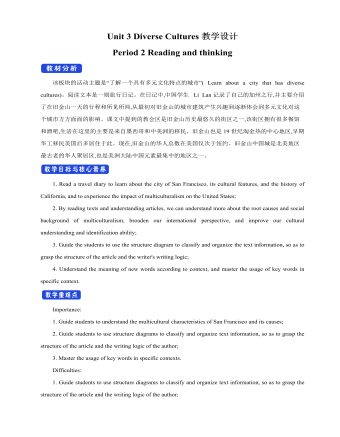
新人教版高中英语必修3Unit 3 Diverse Cultures教学设计二
(2)Consolidate key vocabulary.Ask the students to complete the exercises of activity 6 by themselves. Then ask them to check the answers with their partners.(The first language:Damage of the 1906 San Francisco earthquake and fire.A second language: Yunnan - one of the most diverse provinces in China).Step 5 Language points1. The teacher asks the students to read the text carefully, find out the more words and long and difficult sentences in the text and draw lines, understand the use of vocabulary, and analyze the structure of long and difficult sentences.2. The teacher explains and summarizes the usage of core vocabulary and asks the students to take notes.3. The teacher analyzes and explains the long and difficult sentences that the students don't understand, so that the students can understand them better.Step 6 Homework1. Read the text again, in-depth understanding of the text;2. Master the use of core vocabulary and understand the long and difficult sentences.3. Complete relevant exercises in the guide plan.1、通过本节内容学习,学生是否理解和掌握阅读文本中的新词汇的意义与用法;2、通过本节内容学习,学生能否结合文本特点了解文章的结构和作者的写作逻辑;3、通过本节内容学习,学生能否了解旧金山的城市风貌、文化特色,以及加利福尼亚州的历史,体会多元文化对美国的影响。
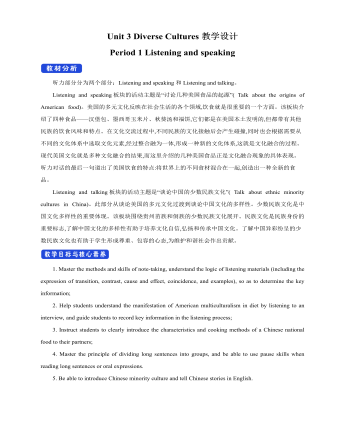
新人教版高中英语必修3Unit 3 Diverse Cultures教学设计一
Activity 81.Grasp the main idea of the listening.Listen to the tape and answer the following questions:Who are the two speakers in the listening? What is their relationship?What is the main idea of the first part of the listening? How about the second part?2.Complete the passage.Ask the students to quickly review the summaries of the two listening materials in activity 2. Then play the recording for the second time.Ask them to complete the passage and fill in the blanks.3.Play the recording again and ask the students to use the structure diagram to comb the information structure in the listening.(While listening, take notes. Capture key information quickly and accurately.)Step 8 Talking Activity 91.Focus on the listening text.Listen to the students and listen to the tape. Let them understand the attitudes of Wu Yue and Justin in the conversation.How does Wu Yue feel about Chinese minority cultures?What does Justin think of the Miao and Dong cultures?How do you know that?2.learn functional items that express concerns.Ask students to focus on the expressions listed in activity. 3.And try to analyze the meaning they convey, including praise (Super!).Agree (Exactly!)"(You're kidding.!)Tell me more about it. Tell me more about it.For example, "Yeah Sure." "Definitely!" "Certainly!" "No kidding!" "No wonder!" and so on.4.Ask the students to have conversations in small groups, acting as Jsim and his friends.Justin shares his travels in Guizhou with friends and his thoughts;Justin's friends should give appropriate feedback, express their interest in relevant information, and ask for information when necessary.In order to enrich the dialogue, teachers can expand and supplement the introduction of Miao, dong, Lusheng and Dong Dage.After the group practice, the teacher can choose several groups of students to show, and let the rest of the students listen carefully, after listening to the best performance of the group, and give at least two reasons.
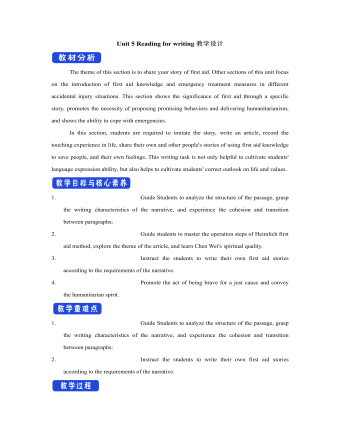
新人教版高中英语选修2Unit 5 Reading for writing教学设计
你校英语报计划出版一期急救常识专刊,现面向全校学生公开征集稿件,你有意参加。请你根据下面提示内容,用英语写一篇短文,介绍在车祸现场对伤者进行急救的方法和步骤。1.确保现场的安全;2.询问伤者,确保其呼吸正常;3.检查伤口,如流血则应采取止血措施;4.如需急救,确保其处于康复位置。注意:1.词数80左右;2.可以适当增加细节,以使行文连贯。参考词汇:康复位置 recovery positionAs we all know, having a knowledge of first aid can make a great difference in our daily life. If a traffic accident happens and someone is injured, the following steps can be used to treat the injured.In the first place, we should make sure that the accident scene is safe so that we won’t get hurt. We should ask the injured person if he is OK, and see if he is breathing. What’s more, we should check for cuts and wounds. If he is bleeding badly, it is vital that we should try to stop the bleeding by applying pressure to the injury. This is because if a person loses too much blood, he may die. If necessary, take the injured person to the hospital as soon as possible.Do remember: when giving first aid, please be sure to place the person in a recovery position.

新人教版高中英语选修2Unit 3 Reading for writing教学设计
The theme of this part is to write an article about healthy diet. Through reading and writing activities, students can accumulate knowledge about healthy diet, deepen their understanding of the theme of healthy diet, and reflect on their own eating habits. This text describes the basic principles of healthy diet. The author uses data analysis, definition, comparison, examples and other methods. It also provides a demonstration of the use of conjunctions, which provides important information reference for students to complete the next collaborative task, writing skills, vivid language materials and expressions.1. Teach Ss to learn and skillfully use the new words learned from the text.2. Develop students’ ability to understand, extract and summarize information.3. Guide students to understand the theme of healthy diet and reflect on their own eating habits.4. To guide students to analyze and understand the reading discourse from the aspects of theme content, writing structure, language expression, etc., 5. Enable Ss to write in combination with relevant topics and opinions, and to talk about their eating habits.1. Guide students to analyze and understand the reading discourse from the aspects of theme content, writing structure, language expression, etc.2. Enable them to write in combination with relevant topics and opinions, and to talk about their eating habits.3. Guide the students to use the cohesive words correctly, strengthen the textual cohesion, and make the expression fluent and the thinking clear.Step1: Warming upbrainstorm some healthy eating habits.1.Eat slowly.2.Don’t eat too much fat or sugar.3.Eat healthy food.4.Have a balanced diet.Step2: Read the passage and then sum up the main idea of each paragraph.
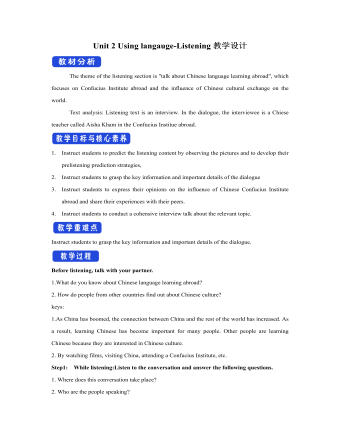
新人教版高中英语选修2Unit 2 Using langauge-Listening教学设计
? B: Absolutely! Getting involved with Chinese cultural activities there definitely helped a lot. I got to practice my Chinese on a daily basis, and I could learn how native Chinese speakers spoke.? A: What do you feel is your biggest achievement?? B: Learning Chinese characters! I have learnt about 1,500 so far. When I first started, I didn't think it was even going to be possible to learn so many, but now I find that I can read signs, menus, and even some easy newspaper articles.? A: What are you most keen on?? B: I've really become keen on learning more about the Chinese culture, in particular Chinese calligraphy. As I have learnt Chinese characters, I have developed a great appreciation for their meaning. I want to explore Chinese characters by learning how to write them in a more beautiful way. ? A: Finally, what do you want to say to anyone interested in learning Chinese?? I have really become keen on learning more about the Chinese culture, in particular Chinese Calligraphy. As I have learnt Chinese character, I have developed a great appreciation for their meaning. I want to explore Chinese characters by learning how to write them in a more beautiful way.? A: Finally, what do you want to say to anyone interested in learning Chinese?? B: I'd say, give it a shot! While some aspects may be difficult, it is quite rewarding and you will be happy that you tried.? A: Thanks for your time. ? B:You're welcome.
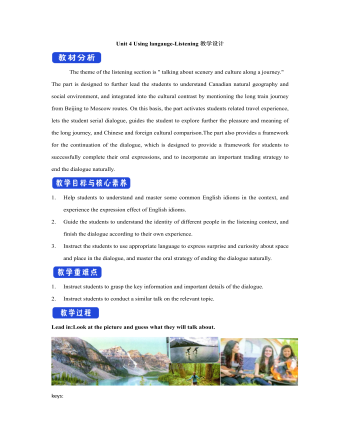
新人教版高中英语选修2Unit 4 Using langauge-Listening教学设计
The theme of the listening section is " talking about scenery and culture along a journey."The part is designed to further lead the students to understand Canadian natural geography and social environment, and integrated into the cultural contrast by mentioning the long train journey from Beijing to Moscow routes. On this basis, the part activates students related travel experience, lets the student serial dialogue, guides the student to explore further the pleasure and meaning of the long journey, and Chinese and foreign cultural comparison.The part also provides a framework for the continuation of the dialogue, which is designed to provide a framework for students to successfully complete their oral expressions, and to incorporate an important trading strategy to end the dialogue naturally.1. Help students to understand and master some common English idioms in the context, and experience the expression effect of English idioms.2. Guide the students to understand the identity of different people in the listening context, and finish the dialogue according to their own experience.3. Instruct the students to use appropriate language to express surprise and curiosity about space and place in the dialogue, and master the oral strategy of ending the dialogue naturally.1. Instruct students to grasp the key information and important details of the dialogue.2. Instruct students to conduct a similar talk on the relevant topic.
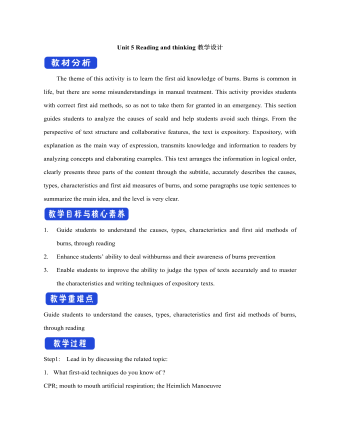
新人教版高中英语选修2Unit 5 Reading and thinking教学设计
The theme of this activity is to learn the first aid knowledge of burns. Burns is common in life, but there are some misunderstandings in manual treatment. This activity provides students with correct first aid methods, so as not to take them for granted in an emergency. This section guides students to analyze the causes of scald and help students avoid such things. From the perspective of text structure and collaborative features, the text is expository. Expository, with explanation as the main way of expression, transmits knowledge and information to readers by analyzing concepts and elaborating examples. This text arranges the information in logical order, clearly presents three parts of the content through the subtitle, accurately describes the causes, types, characteristics and first aid measures of burns, and some paragraphs use topic sentences to summarize the main idea, and the level is very clear.1. Guide students to understand the causes, types, characteristics and first aid methods of burns, through reading2. Enhance students’ ability to deal withburnss and their awareness of burns prevention3. Enable students to improve the ability to judge the types of texts accurately and to master the characteristics and writing techniques of expository texts.Guide students to understand the causes, types, characteristics and first aid methods of burns, through readingStep1: Lead in by discussing the related topic:1. What first-aid techniques do you know of ?CPR; mouth to mouth artificial respiration; the Heimlich Manoeuvre
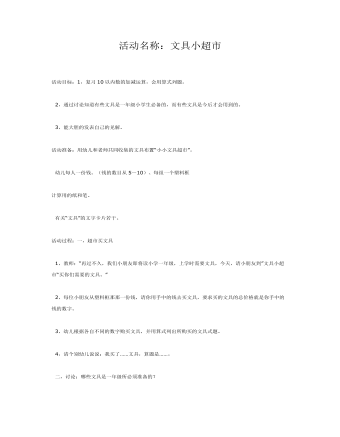
大班数学:文具小超市课件教案
2,通过讨论知道有些文具是一年级小学生必备的,而有些文具是今后才会用到的。 3,能大胆的发表自己的见解。活动准备:用幼儿和老师共同收集的文具布置“小小文具超市”。 幼儿每人一份钱。(钱的数目从5~10)、每组一个塑料框计算用的纸和笔。 有关“文具”的文字卡片若干。
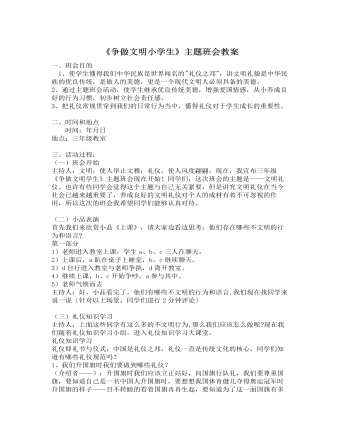
《争做文明小学生》主题班会教案
国旗代表着我们的国家,升国旗是一件神圣而庄严的事,我们不应该当作儿戏,不应该说话打闹而要尊重它、爱护它。2、我们在学校内要做到哪些?学生1:我们作为现代化新人,应该讲究文明礼仪。我个人认为要做到校园文明礼仪有三大点:首先,在学校要尊重老师。在个人方面要做到不打架、不骂人、不吸烟、不喝酒,仪容仪表要符合学校规范。在同学之间要做到互帮互助、团结友爱,创造出一种积极向上良好的范围。3、那我们在公共场合呢?学生2说:不去游戏厅、网吧。学生3:看见垃圾随手拣起来仍到垃圾箱里。不玩危险的游戏。学生4:不去危险的地方玩。学生5:尊老爱幼,不大声喧哗,不随地吐谈。学生6:不浪费水资源,讲卫生。学生7;不吃陌生人的东西,不和陌生人说话。学生8:不在教室里乱跑,不拿别人的东西。
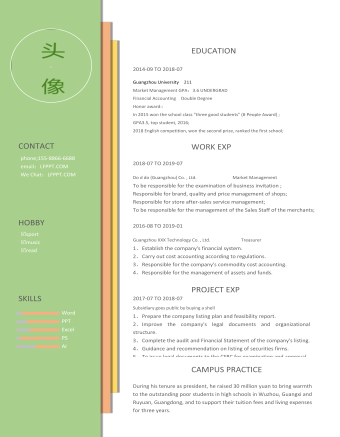
英文简历+中文简历
GuangzhouUniversity 211Market Management GPA:3.6 UNDERGRADFinancial Accounting Double DegreeHonor award::In 2015 won the school class"three good students" (# People Award) ;GPA3.5, top student, 2016;2018 English competition, won thesecond prize, ranked the first school;
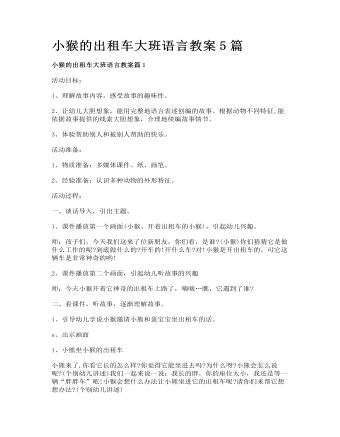
小猴的出租车大班语言教案5篇
1、讲述故事,加深理解。教师操作教具,讲述故事,穿插提问:a小猴发现蛋宝宝和小熊遇到什么困难?如果你是小猴你会怎样解决这个问题?请小朋友积极想办法。b小朋友听故事里的小猴是怎样做的。乘客对小猴设计的出租车是否“满意”(出示字卡满意),为什么?你们喜欢小猴和它的出租车吗?是否也“满意”?2、大胆想象仿编故事。引发仿编兴趣:小猴的名气越来越大了,森林里的小动物都来坐它的出租车。提问:长颈鹿和小刺猬遇到了什么困难?小猴是怎样解决的?森林里还有谁也乘坐小猴的出租车?他们可能遇到什么困难?小猴能解决吗?我们也帮小猴想想让所有的小动物都能顺利的乘坐出租车。(幼儿分组讨论,仿编故事,鼓励幼儿把故事讲给大家听。)
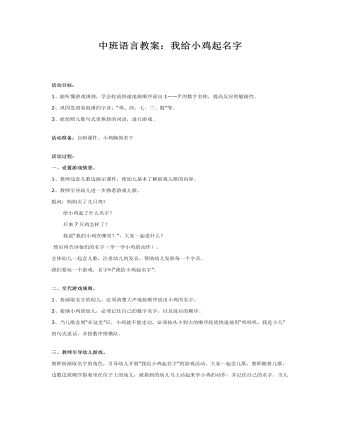
中班语言教案:我给小鸡起名字
活动准备:自制课件、小鸡胸饰若干活动过程:一、设置游戏情景。 1、教师边念儿歌边演示课件,使幼儿基本了解游戏儿歌的内容。 2、教师引导幼儿进一步熟悉游戏儿歌。 提问:妈妈买了几只鸡? 给小鸡起了什么名字? 后来7只鸡怎样了? 我说“我的小鸡在哪里?”,大家一起说什么? 然后再告诉他们的名字(学一学小鸡的动作)。 全体幼儿一起念儿歌,注意幼儿的发音,帮助幼儿发准每一个字音。 我们要玩一个游戏,名字叫“我给小鸡起名字”。二、交代游戏规则。 1、扮演取名字的幼儿,必须清楚大声地按顺序说出小鸡的名字。 2、扮演小鸡的幼儿,必须记住自己的数字名字,以及前后的顺序。 3、当儿歌念到“在这里”后,小鸡就不能走动,必须按从小到大的顺序轮流快速地用“叽叽叽,我是小几”的句式说话,并按数序排横队。
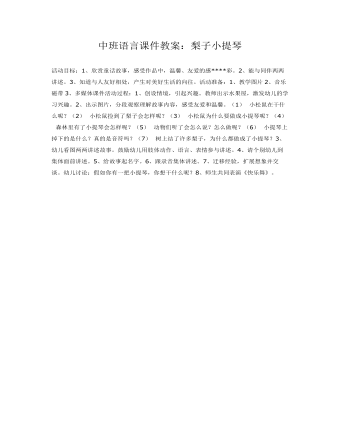
中班语言课件教案:梨子小提琴
活动目标:1、欣赏童话故事,感受作品中,温馨、友爱的感****彩。2、能与同伴两两讲述。3、知道与人友好相处,产生对美好生活的向往。活动准备:1、教学图片2、音乐磁带3、多媒体课件活动过程:1、创设情境,引起兴趣。教师出示水果屋,激发幼儿的学习兴趣。2、出示图片,分段观察理解故事内容,感受友爱和温馨。(1) 小松鼠在干什么呢?(2) 小松鼠捡到了梨子会怎样呢?
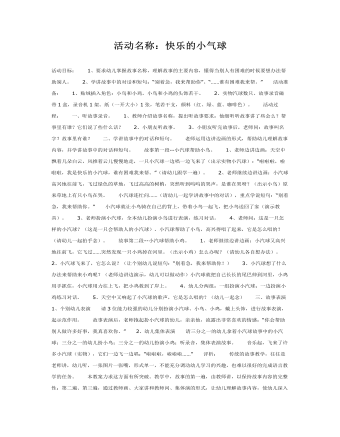
中班语言课件教案:快乐的小气球
2、实物汽球数只。故事录音磁带1盒,录音机1架。纸(一开大小)1张,笔若干支,颜料(红、绿、蓝、咖啡色)。 活动过程: 一、听故事录音。 1、教师介绍故事名称,提出听故事要求:他细听听故事讲了些会么?帮事里有谁?它们说了些什么话? 2、小朋友听故事。 3、小朋友听完故事后,老师问:故事叫名字?故事里有谁? 二、学讲故事中的对话和短句。 老师运用边讲边画的形式,帮助幼儿理解故事内容,并学讲故事中的对话和短句。 故事第一段--小汽球帮助小鸟。 1、老师边讲边画:天空中飘着几朵白云,风推着云儿慢慢地走,一只小汽球一边唱一边飞来了(出示实物小汽球):“啦啦啦,啦啦啦,我是快乐的小汽球,谁有困难我来帮。”(请幼儿跟学一遍)。 2、老师继续边讲边画:小汽球高兴地往前飞,飞过绿色的草地,飞过高高的树梢,突然听到呜呜的哭声,是谁在哭呀?(出示小鸟)原来草地上有只小鸟在哭。 小汽球连忙问……(请幼儿一起学讲故事中的对话),重点学说短句:“别着急,我来帮助你。” 小汽球就让小鸟骑在自己的背上,带着小鸟一起飞,把小鸟送回了家(演示教具)。
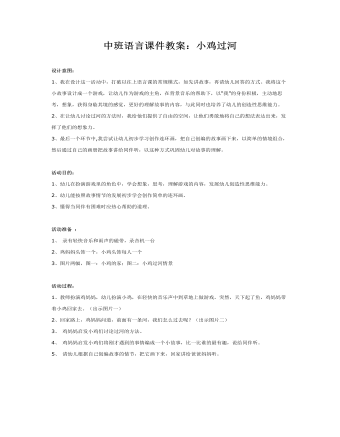
中班语言课件教案:小鸡过河
2、在让幼儿讨论过河的方法时,我给他们提供了自由的空间,让他们勇敢地将自己的想法表达出来,发挥了他们的想象力。 3、最后一个环节中,我尝试让幼儿初步学习创作连环画,把自己创编的故事画下来,以简单的情境组合,然后通过自己的画册把故事讲给同伴听,以这种方式巩固幼儿对故事的理解。活动目的:1、幼儿在扮演游戏里的角色中,学会想象,思考,理解游戏的内容,发展幼儿创造性思维能力。 2、幼儿能按照故事情节的发展初步学会创作简单的连环画。 3、懂得当同伴有困难时应热心帮助的道理。
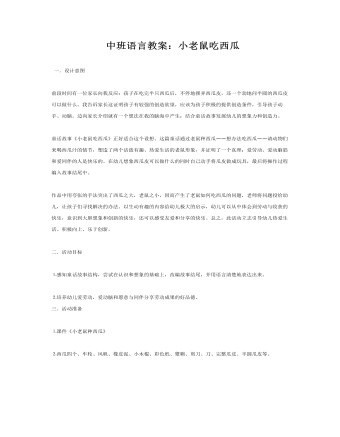
中班语言教案:小老鼠吃西瓜
二.活动目标⒈感知童话故事结构,尝试在认识和想象的基础上,改编故事结尾,并用语言清楚地表达出来。⒉培养幼儿爱劳动,爱动脑和愿意与同伴分享劳动成果的好品德。三.活动准备⒈课件《小老鼠种西瓜》⒉西瓜四个、车轮、风帆、橡皮泥、小木棍、彩色纸、漿糊、剪刀、刀、完整瓜皮、半圆瓜皮等。四.活动过程一、 欣赏故事⒈教师以提问的方法引出故事名称,引起幼儿注意。⒉讲述第一遍故事,边讲边播放 <BR><P></P>课件。(出现大西瓜和小老鼠在屏幕上,突出西瓜大、老鼠小)⒊讲述第二遍故事,边讲述边播放。(动画型式播放故事基本内容)





















